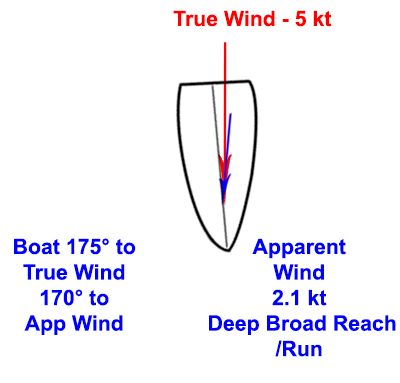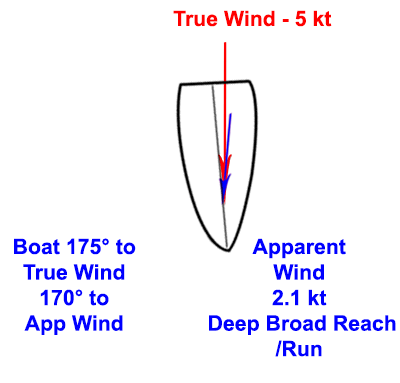Demystifying Apparent Wind - Part 3
The last in the series - Apparent Wind downwind.
It's hard to steer downwind. The waves toss the boat around more, and if you get tossed too much, you'll gybe when you don't want to. You can capsize on a broad reach in heavy winds and seas.
The biggest thing you have to deal with is apparent wind. On a downwind course, small changes in course, wind speed, and wind direction produce large changes in apparent wind.
We'll use the same 5 kt. true wind we've used before and the same Bahia-like boat. You're almost dead downwind - just 5 degrees short of it. Here's what it looks like:
Note that the boat is about 5 degrees off dead downwind to the true wind, but 10 degrees off dead downwind to the apparent wind.
Now something changes by 10 degrees in the downwind direction. You might change course by 10 degrees farther downwind, the wind might shift 10 degrees clockwise, or the waves might push the boat 10 degrees downwind. Now you're here, which is the mirror image of the above:
Here it is in animation:
Doesn't look like a lot, but look at the numbers. A 10 degree change in course or wind direction produced double that in boat angle to the apparent wind - from 10 degrees off dead downwind on one side to 10 degrees off dead downwind on the other side. Enough to send you into flying gybe land.
This sensitivity of apparent wind to small changes on a downwind course is one of the reasons steering downwind is so challenging. Steven Colgate discusses this in his book Colgate's Basic Sailing Theory, the reference book for the Senior written exam.
But apparent wind can be your friend on a gybe. You don't need a diagram to understand this. You're going dead downwind, so your boat speed is cancelling some of the true wind. You're also surfing the waves that the wind is creating. You slow down as you go up the crest of the wave, and you accelerate as you slide down the back side. We'll assume the wind is constant. So as you go up
the crest and your boat speed slows, you cancel less of the true wind, and the apparent wind speeds up. Conversely, as you surf down the wave, your boat speed increases, you cancel more of the true wind, and the apparent wind decreases.
This can help you in timing your gybe, if you have the option to time it. Do it when you accelerate down a wave. The apparent wind diminishes, and so does the force on your rig. It's a gybe in a lesser wind, so it's easier and gentler.
This concludes the Apparent Wind blogs. I hope they've been useful.
When you subscribe to the blog, we will send you an e-mail when there are new updates on the site so you wouldn't miss them.





Comments